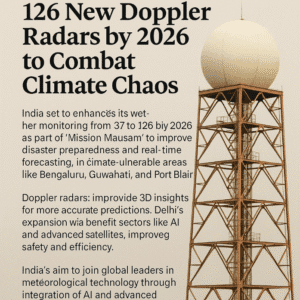India’s Radar Expansion: 126 New Doppler Radars by 2026 to Combat Climate Chaos
India is set to enhance its weather monitoring by expanding its Doppler radar network from 37 to 126 by 2026. This initiative, part of the “Mission Mausam” program, aims to improve disaster preparedness and real-time weather forecasting, especially in climate-vulnerable areas like Bengaluru, Guwahati, and Port Blair. Doppler radars will provide 3D insights for more accurate predictions of cyclones, storms, and other weather events. In Delhi, the Automatic Weather Stations will increase to 100 to manage heatwaves and floods.
This expansion will benefit sectors like agriculture, aviation, and fisheries, improving safety and efficiency. By integrating AI and advanced satellites, India aims to join global leaders in meteorological technology. With rising climate extremes, this move signals a proactive step toward a more resilient future.

India’s Radar Expansion: 126 New Doppler Radars by 2026 to Combat Climate Chaos
In a bold move to combat escalating climate challenges, India has unveiled plans to dramatically enhance its weather monitoring capabilities by doubling its Doppler radar network by 2026. This initiative, announced by Union Minister Dr. Jitendra Singh, aims to transform the nation’s disaster preparedness and real-time weather forecasting, ensuring “no weather hazard goes undetected.”
From 37 to 126 Radars: A Timeline of Transformation
Currently operating 37 Doppler Weather Radars (DWRs), India will expand this network to 73 by 2025–26, with a further surge to 126 by the following year. These high-tech radars, which use microwave signals to track precipitation, wind patterns, and storm intensity, will fill critical gaps in coverage, particularly in disaster-prone regions. Key cities prioritized for new installations include Bengaluru (notorious for urban flooding), Guwahati (vulnerable to monsoon extremes), Port Blair (at risk of cyclones), and Ahmedabad, Raipur, and Ranchi—regions grappling with erratic rainfall and heatwaves.
Why Doppler Radars Matter
Unlike conventional radars, DWRs provide 3D insights into weather systems, enabling precise tracking of cyclones, thunderstorms, and cloudbursts. For instance, during the 2023 Himachal Pradesh floods, limited radar coverage delayed early warnings. The expanded network promises to reduce such lapses, offering granular data to predict localized events, like Mumbai’s torrential rains or Odisha’s cyclones, with greater accuracy.
Delhi’s Forecasting Overhaul: A Case Study
The capital, Delhi, will see its Automatic Weather Stations (AWS) multiply from 18 to 100, with 50 set for immediate installation. This upgrade responds to the city’s escalating weather crises, including record-breaking heatwaves and sudden floods. Enhanced AWS networks will monitor hyperlocal microclimates, aiding in pollution control and urban flood management—critical for a metropolis battling environmental and infrastructural stress.
Sector-Wide Impacts: Beyond Disaster Management
- Agriculture: Timely monsoon predictions could revolutionize farming, where 60% of crops rely on rain. Accurate forecasts help farmers optimize sowing and irrigation.
- Aviation: Improved turbulence and storm detection enhances flight safety, reducing disruptions at hubs like Delhi and Bengaluru airports.
- Fisheries: Coastal communities will receive advance cyclone alerts, safeguarding lives and livelihoods.
Mission Mausam: Building a Weather-Ready Nation
The radar expansion is part of ‘Mission Mausam,’ a broader initiative to modernize India’s meteorological infrastructure. This includes deploying advanced satellites, AI-driven prediction models, and automated weather stations. The focus is on “impact-based forecasting”—not just predicting a cyclone, but estimating its societal and economic fallout.
A Climate-Resilient Future
Dr. Singh underscored the urgency of these upgrades amid rising climate extremes, citing recent events like Cyclone Amphan (2020) and the 2024 Assam floods. With the new network, India aims to join global leaders like Japan and the U.S. in weather tech, while shielding vulnerable populations.
As temperatures soar and storms intensify, India’s radar expansion marks a proactive step toward climate resilience—turning data into actionable insights for millions. The message is clear: in the era of climate uncertainty, foresight is the best defense.
You must be logged in to post a comment.